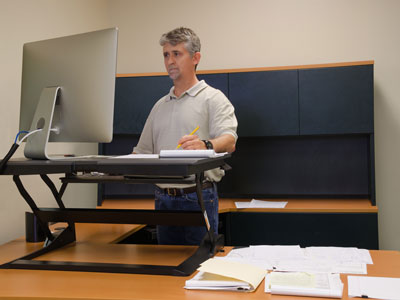What Is Ergonomic Office Furniture?

Overview
Ergonomics – derived from the Greek words ‘ergon’ (work) and ‘nomoi’ (natural laws) – seeks to understand the interaction between humans and the systems they work with. The result? Design principles that bridge the gap between function and human well-being. In office settings, ergonomic office furniture isn’t just a buzzword; it’s the confluence of design, science, and comfort, ensuring that the work environment complements human capability and minimizes stress.
Types of Ergonomic Office Furniture
Ergonomic Chairs
Gone are the days of static, hard-backed chairs. The modern ergonomic chair offers adjustable height, lumbar support, swiveling capacity, and armrests tailored to reduce shoulder and back strain.
Sit-Stand Desks
Flexibility is at the core of ergonomics, and these desks manifest it. They allow employees to alternate between sitting and standing, reducing the risks associated with prolonged sedentary positions.
Keyboard and Mouse Designs
With carpel tunnel syndrome a prevalent concern, ergonomically designed keyboards and mice reduce wrist strain, promoting natural hand and wrist postures.
Monitor Stands
Positioning your monitor at eye level can alleviate neck strain. The Ergonomic monitor caters to this need, ensuring that the screen is at the optimal viewing height and angle.
Footrests and Desk Accessories
Even the minutiae matter in ergonomics. Footrests help maintain appropriate foot positioning, while desk accessories, like document holders, are strategically designed to minimize neck and eye movement.
Benefits of Ergonomic Office Furniture
Enhanced Productivity
A comfortable employee is an efficient one. Ergonomic furniture facilitates better posture, less fatigue, and reduced discomfort, increasing concentration and productivity.
Reduced Healthcare Costs
Injuries from poor office furniture, such as back pain and repetitive strain injuries, increase medical expenses. Investing in ergonomic furniture is a proactive approach to minimize these costs.
Employee Well-being
Beyond the tangible, ergonomic furniture is a testament to an organization’s commitment to its staff’s well-being, fostering morale, job satisfaction, and loyalty.
Improved Aesthetics
Function and form often go hand-in-hand. With its sleek designs, Ergonomic furniture adds a modern touch to the office landscape.
Things to Consider
Personalization
Ergonomics is not one-size-fits-all. Each individual has unique needs; adjustability should be paramount in your ergonomic choices.
Integration
It’s essential to ensure that all office elements – from the chair to the keyboard – are cohesive and ergonomically aligned.
Training
Merely investing in ergonomic furniture is not the silver bullet. Employees need training on the correct use and adjustment of the table.
Budget
While ergonomic furniture can seem like a hefty investment upfront, it’s prudent to view it as a long-term investment in health, productivity, and overall business success.
Get Ergonomics Training with E3 Consulting
Understanding ergonomic office furniture’s ‘what’ and ‘why’ is just the beginning. Proper implementation and usage are equally vital. At E3 Consulting, we don’t just recommend; we educate. Our bespoke ergonomics training sessions are crafted to ensure that your team maximizes the benefits of your ergonomic investments.
From chair adjustments to optimal desk setups, we dive deep, equipping you with the knowledge to create a harmonious work environment. Don’t just adapt to the workspace; make the workspace adapt to you. Reach out to E3 Consulting today, and let’s redefine your office’s relationship with comfort, productivity, and well-being.

